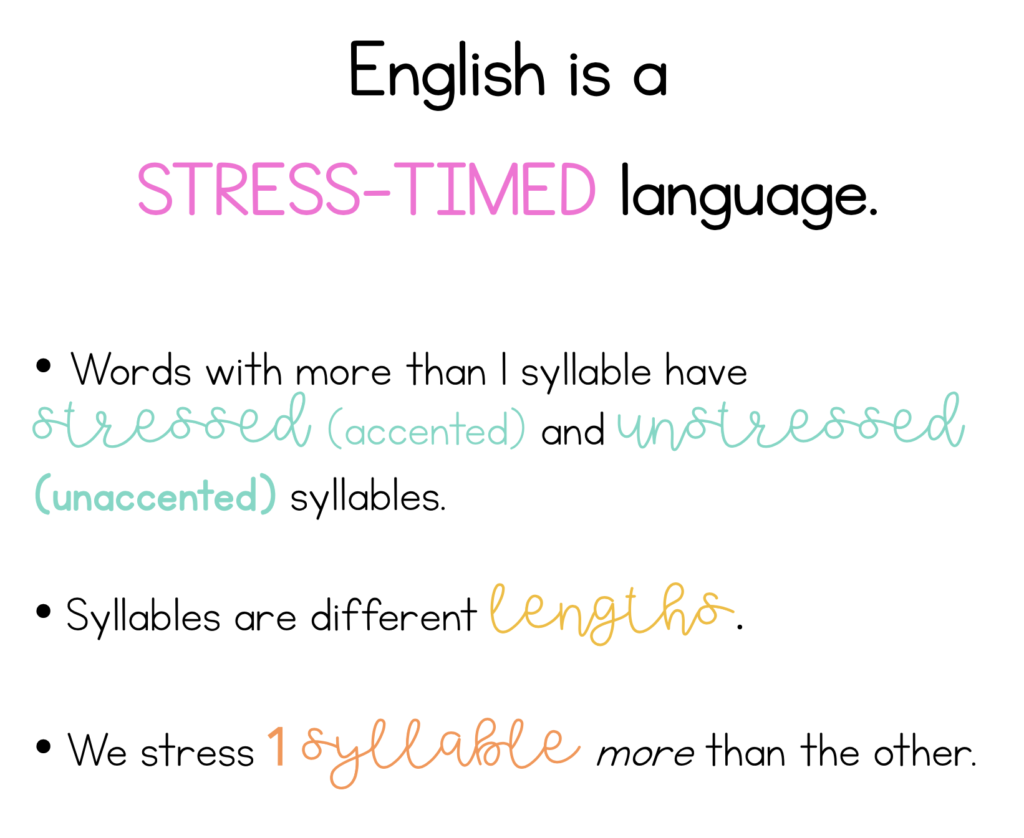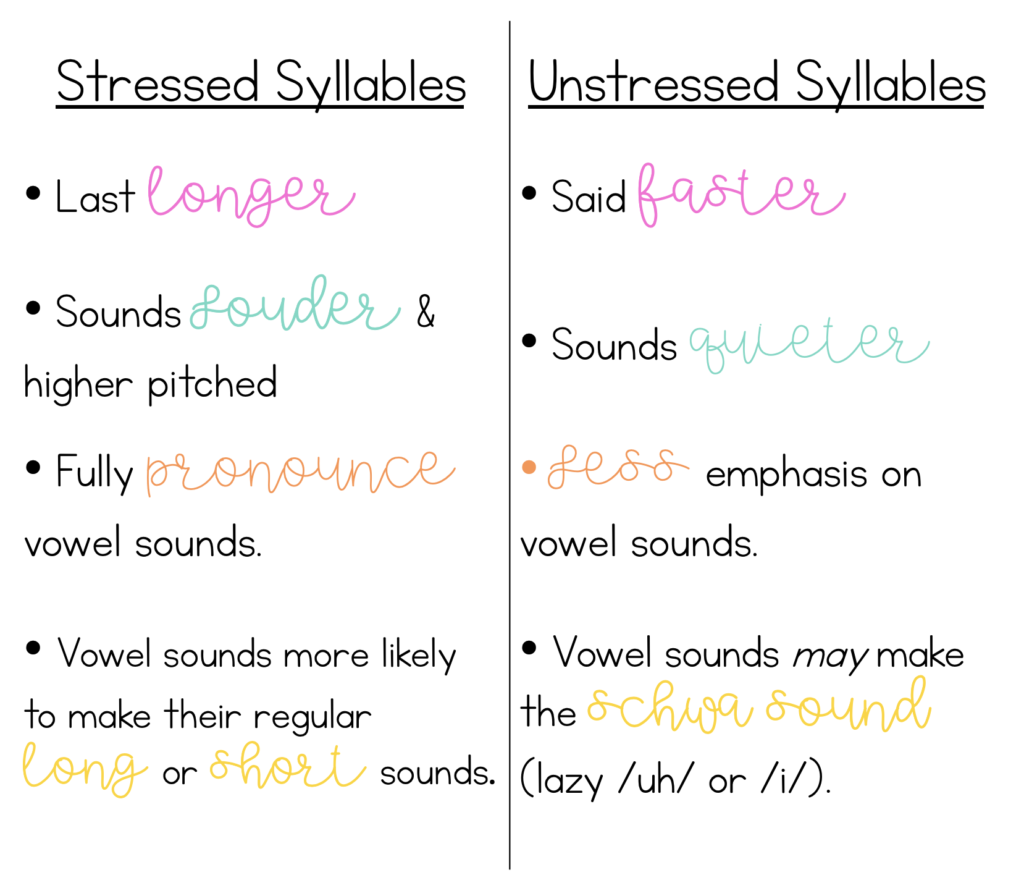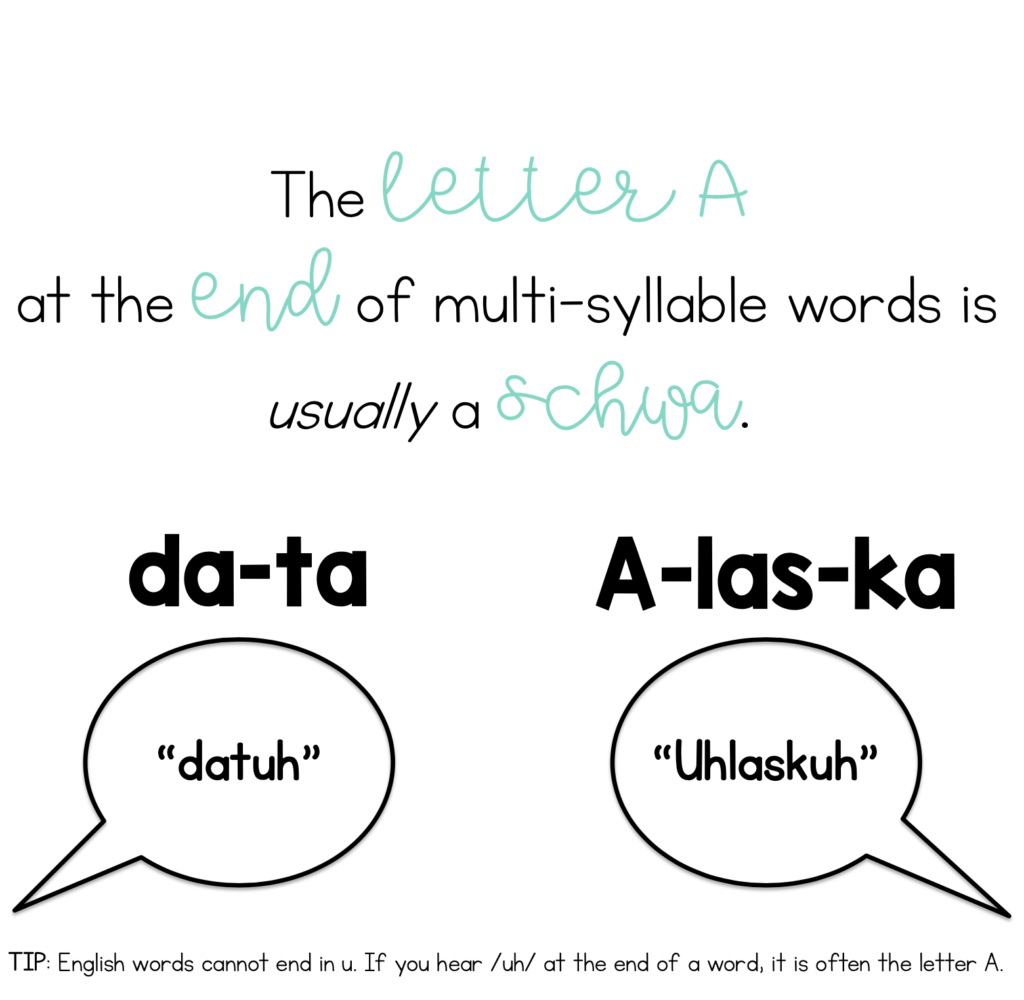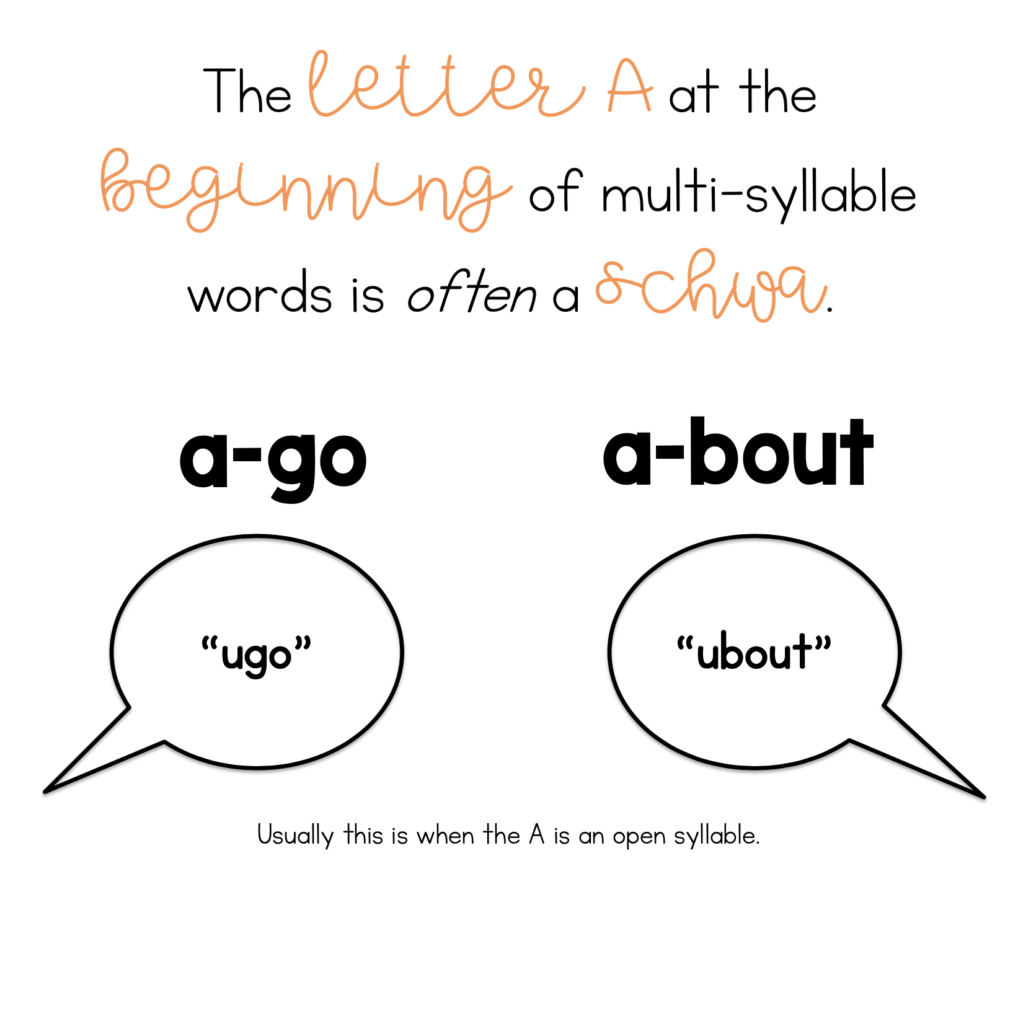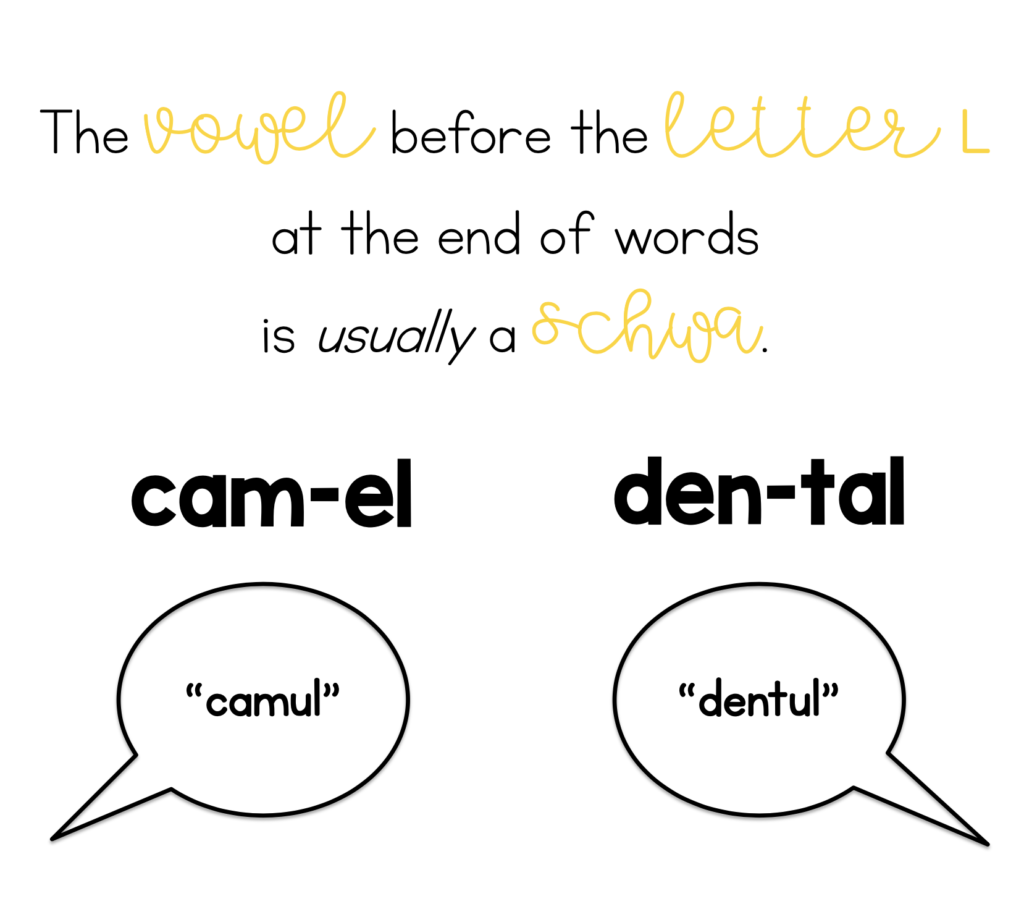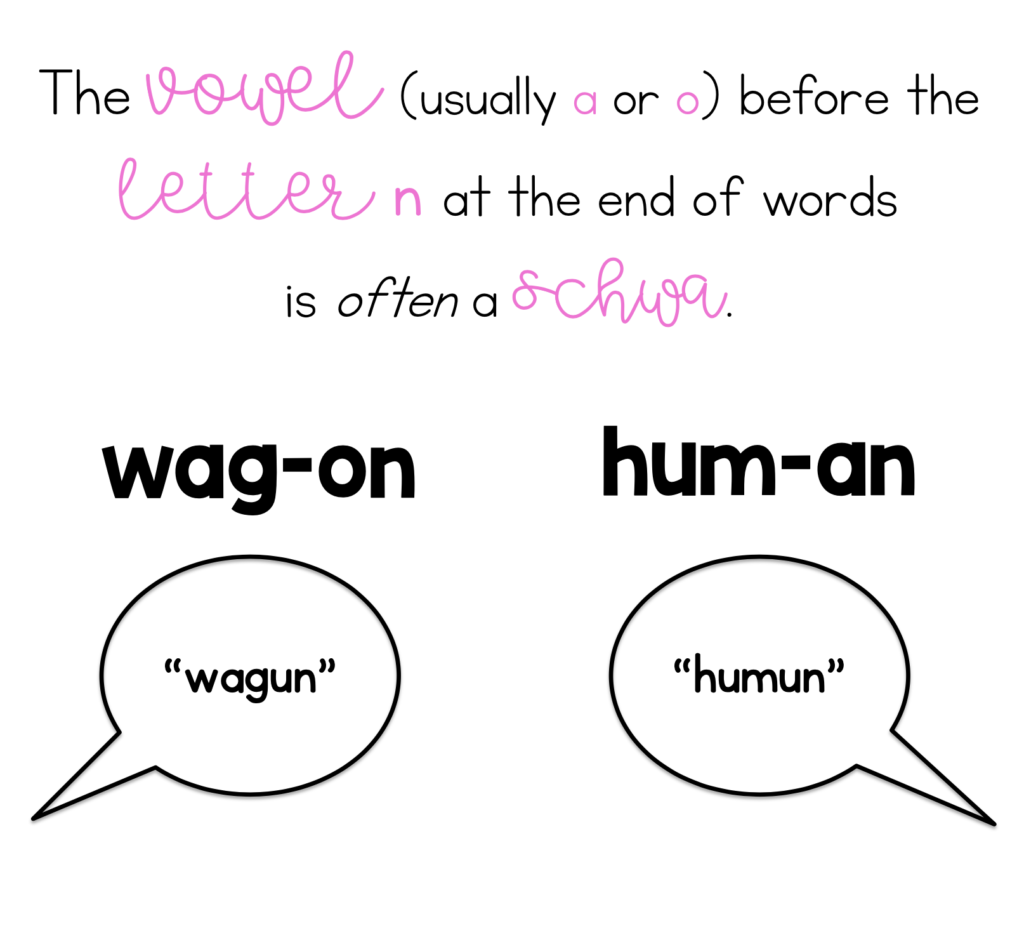Good morning! Today I’m excited to write about the most common vowel sound that I never knew even existed. That’s right, I got through high school, college, grad school, and several years of teaching and I had never heard of the schwa! I figured I’m probably not alone, so I wanted to take some time to blog about this.
*Disclaimer* I am not a linguist, although I wish I was! I am not claiming to be an expert, just trying to share what I have learned and how I teach this to my students to help them understand our tricky language. I admittedly struggle with expressive language, spelling uncommon words from memory, and grammar. For that reason, I’m sure you will find grammatical errors in all of my posts! I’m just a teacher who loves to learn and wants to understand all of this. If you read something that is within your expertise (or even just an opinion) that you disagree with, please feel free to call me out on it. I consider that a learning opportunity and welcome open, respectful dialogue.
What is the Schwa?
First of all, what the heck is the schwa? Well, think of all those moments when a reader is attempting to sound out a word and they do it perfectly. They say the correct sounds and blend it together perfectly. But wait, they say the wrong word because one of those vowels sounds isn’t quite making the sound it’s supposed to make.
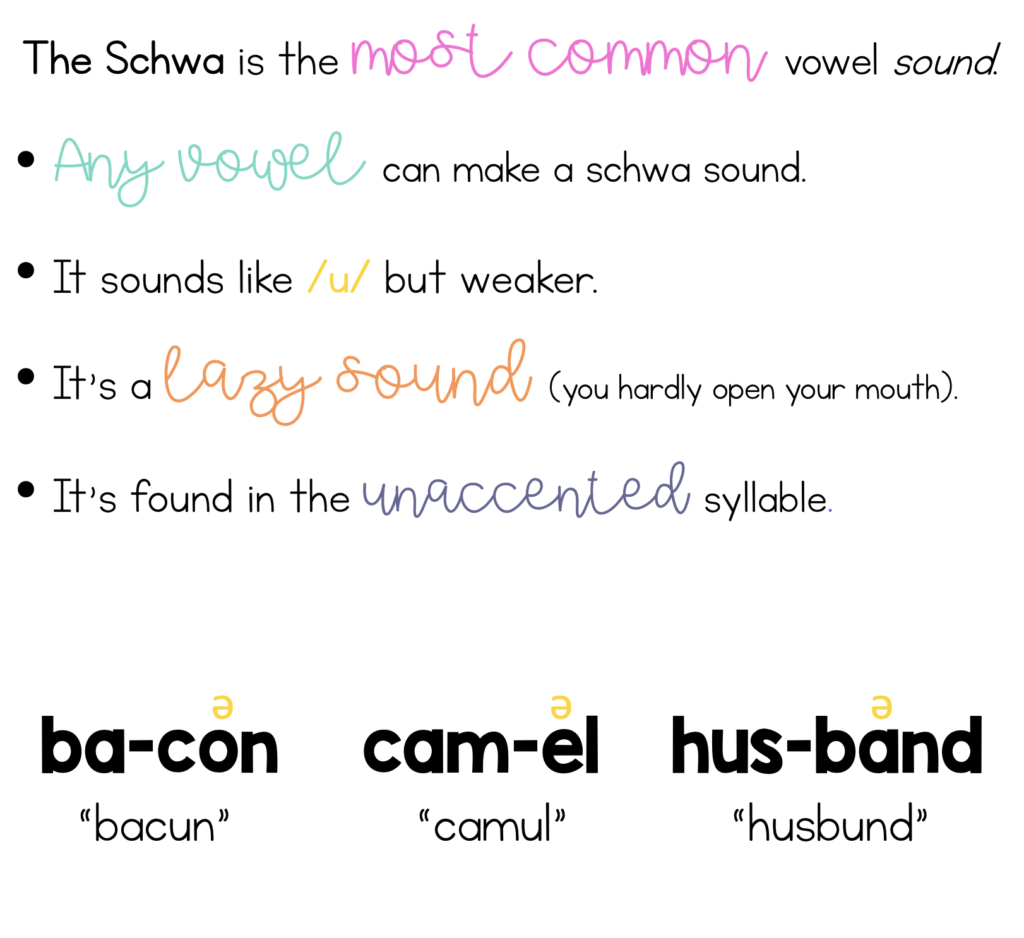
- The schwa is a sound that is represented by all of the vowels.
- It makes the /uh/ sound, but lazier and not as pronounced.
- I would also argue it sometimes sounds like /i/ depending on how you pronounce words. I actually pronounce wagon like wagin, not wagun.
- The schwa sound happens in the syllable that we are not fully pronouncing. This is called the unaccented syllable.
- We always pronounce one syllable more that the others (more about that in a sec), so that leaves the other syllable(s) to not have as much emphasis.
- Because of this, our mouths naturally take the lazy route, which is usually the /uh/ sound. Think of how little you have to move your mouth to make that sound.
- Try saying this sentence enunciating every syllable, using the proper vowel sounds: The camel is pulling seven robins in an orange wagon. See what I mean? It sounds like a robot is talking. Now say it normally and try to focus on the vowel sounds that are sort of dropped or making the /uh/ sound. It probably sounds like this: The caml is pulln sevun robns in n orunge wagun.
One example I can think of that recently came up when I was teaching syllable division rules with 2-syllable words was pilot. Students are always stumped on that one because they are sounding out pi-lot with emphasis on the lot. I would say, “yes, but say it faster!” They would say pilOt again. I capitalize the O in that so you can hear how they are saying it. Some words, like wagon are easier to adjust. They may sound out wag-on, but then they usually can make that transition naturally. “Oh, wagun!” This isn’t the case with pilot usually. So I would tell them how we pronounce it and I would always see confused looks. There are so many words like wagon that are easier to figure out and fix naturally but there are also a lot of words that are not as intuitive, like pilot. I would say the more a student struggles with reading, the harder it is to make those adjustments. I will get into more about the schwa and why it happens.
The Unaccented (Unstressed) Syllable
So now a little bit more about where we find the schwa: The unstressed or unaccented syllable of a word.
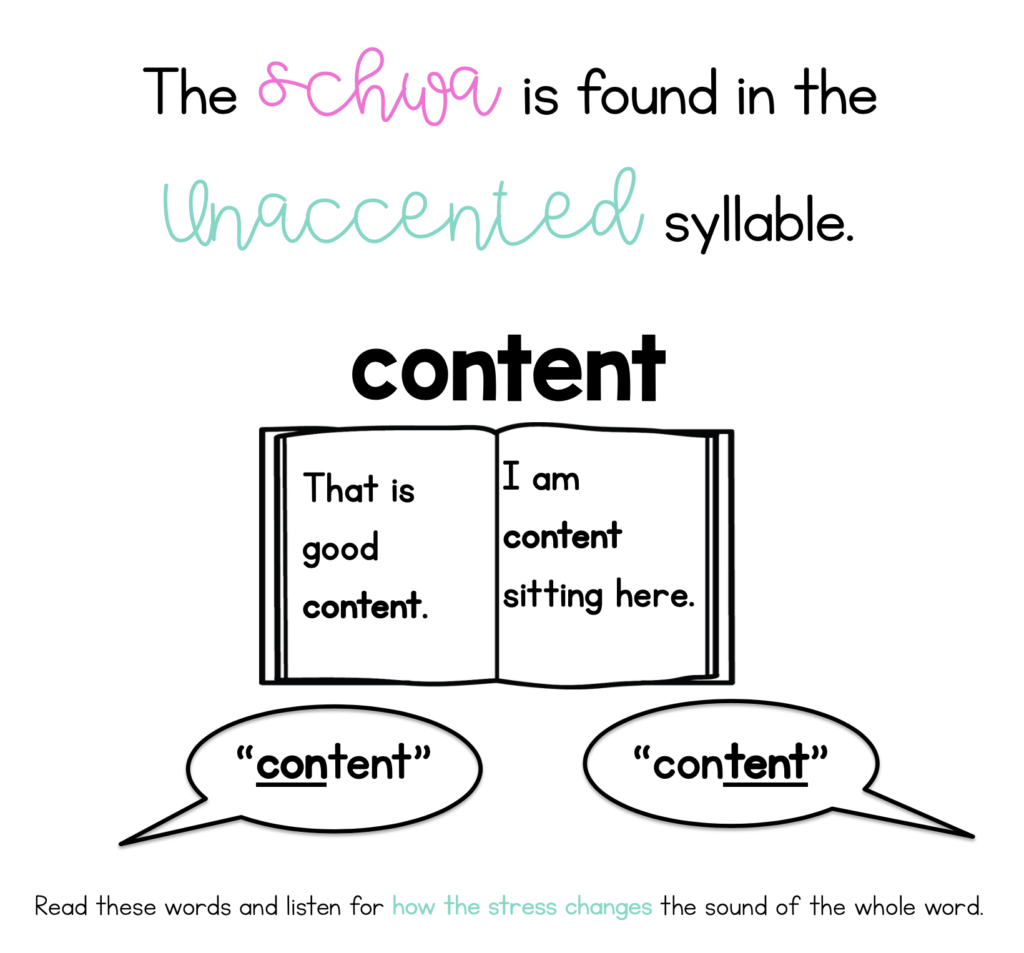
The schwa is found in the unaccented syllable of a word. Like I said, we only stress one syllable. That leaves the other(s) to not be as enunciated. I think these two words are super helpful in understanding that: CONtent and conTENT.
Say these two words in the sentences to hear how the stress changes. With the first example, That is good content, the stress is in the first syllable. We say con a little longer, louder, and even higher pitched. In the second sentence, I am content sitting here, we stress the 2nd syllable tent and sort of mumble con. There happens to be a scha in the con in this usage. Do you hear it? With our mumbling, we end up pronouncing it cun. Notice there is not a schwa in con in the 1st example.
Why do we have Unstressed Syllables?
Here is a little more about the accented/unaccented syllables:
English is stress-timed as opposed to a syllable-timed language.
- In a syllable-timed language, every syllable takes about the same amount of time to say.
- The syllables are about the same length.
- Spanish and French are syllable-time languages.
- In stress-timed languages, one syllable is longer. It sounds awkward otherwise!
- Even within a sentence, not all words are stressed. Usually the content words are stressed and pop out in conversation. The function words usually get minimized (for becomes fr, and becomes n, etc.)
This website has a super helpful video that explains it well and gives examples so you can better understand the concept of a stress-timed language.
How to Identify the Schwa
Now that you know what it is and where you may find it, let’s talk about some common places where you may find it. The tricky thing about the schwa is that there is no way to know exactly where it will be when you are reading. Students have to sort of sound out the word normally then make the adjustment to the schwa sound. This can be so tricky! So truly, my first tip is not the best around, but this has been the best solution so far with my students.
Tip #1 for Identifying the Schwa
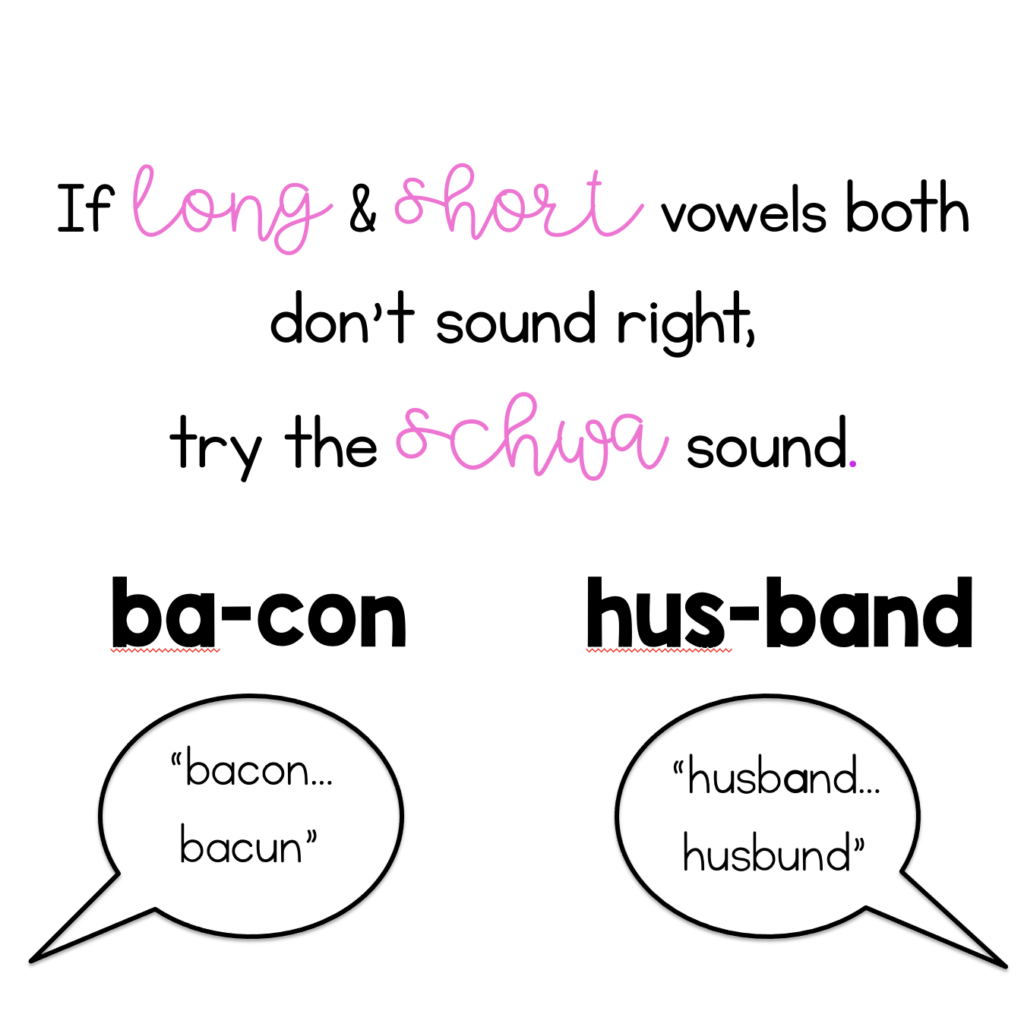
I teach my students to decode the word as they normally would. If the word doesn’t sound like one they know, try to substitute the /uh/ schwa sound in one of the vowels first. The schwa is more often in the 2nd syllable so I always encourage them to try that first.
- For example, when they sound out bay-cOn, they can try substitute the /o/ for /u/ and say bay-cun.
I wish I had a tip that would work every time and make it easier, but… I do believe this is when context is so important. I always want my students to use their phonics and morphology knowledge but context is super helpful with the schwa. If you are reading the word bacon in a sentence, you’re much more likely to self correct bacOn to bacun if it has words around it that provide context.
Tip #2 for Identifying the Schwa
This next one is one that I can say is almost always true. I say almost always because I can’t think of a case when it doesn’t work, but I know one of you will find one! There are always exceptions, right? Here’s a cool tip for you that you may or may not know. English words should not end in u. Are there a few exceptions? Sure. But those are just that: exceptions!
Since English words should not end in u, then we know that when we hear /uh/ (short u sound) at the end of words, there has got to be a substitute. You probably are already thinking of long u subs (ue, ew, etc.). For the short u sound, we usually use the letter <a>. Since <a> is a substitute for the short u sound at the end of words, then we know that if we see an <a> at the end of words, then it likely will make the /uh/ sound. And yep, it’s usually a schwa.
(This is always fun to teach because it explains why the letters <ay> usually makes the long a sound at the end of words. It’s not just an open syllable a! It needs that y after it if it finishes a base word. Keep in mind that you can have an open A syllable without a y, just not a word. I digress, but I think it’s important to note. In the word ba-sic, the <a> says its name on its own because it is an open syllable. However, if I want to write the word bay, I need that <ay> combo because it’s the end of a word. Sorry for my huge veer off the road of this post but I think it’s all relevant!)
Aaaaaaanywaaaay… this is one easy schwa tip that actually works (sofa, comma, panda are some examples).
Tip #3 for Identifying the Schwa
Here’s another tip, but it’s a bit trickier. Think about all of those high-frequency words like ago, again, away, about, around, across and how annoying it is that the <a> doesn’t make its normal sounds. Do you have a lightbulb moment? Yep, all schwas! So technically, they are not rule breakers right? They are just schwas! Let’s see if I can explain this correctly. When a word begins with the letter <a> and it is an OPEN syllable on its own (meaning its the only letter in the syllable), then it is usually a schwa (although I already thought of acorn as an exception).
Tip #4 for Identifying the Schwa
Here’s another one that is always a schwa (as far as I know). At the end of words when there is a vowel then the letter <l>, that combo usually makes this sound: /ul/. I think this one is a little more natural to fix once you’ve tried sounding out words that end in <l>. So you can now tell your students that if it ends with a vowel then an <l>, that vowel will be a schwa and you say /ul/. Make sure you specify that it is at the end of words, because anywhere else in the word, all bets are off. LOL!
Tip #4 for Identifying the Schwa
This last one is not a rule or anything, but just a consistent pattern that you’ll see when you start looking out for the schwa. Often the schwa comes before the letter -n. It’s often an A or an O. (In fact it seems like a and o in general have more obvious schwas than the others). So if you see a word that ends with a vowel then n, that might be a good place to start looking for the schwa. When students are sounding out words, if they know that is a common place that the schwa might be, they can get used to quickly substituting the regular vowel sound for the schwa sound if they get stuck.
Here are all of those tips together:
(NOTE: I probably should put usually instead of always because the only always that is for sure is that there are always exceptions!)
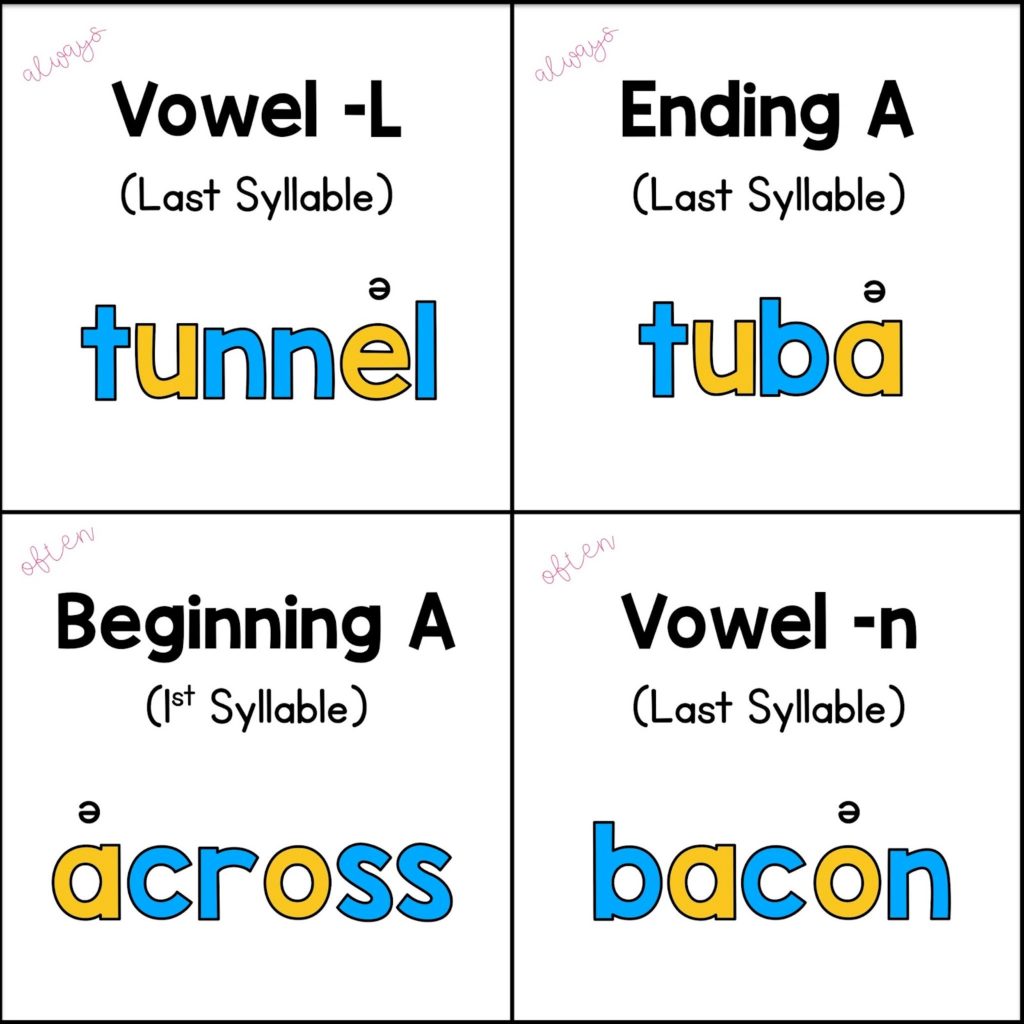
Spelling the Schwa
Now spelling the schwa is a bit of a nightmare. There seems to be no real way to figure it out unless you just know which letter to use. Thank you spell check and dictionaries! That is a frustrating answer for our students who want the answers. It’s true though. Can you think of any way to figuring out the o in wagon just from “sounding it out”? No! You have to sound out the sounds you hear and learn that o is there from seeing it a few times. If your memory can’t hold all of those, that’s where spell checkers are key.
And here is where I go on my soapbox about spell checkers being a great accommodation for our dyslexic learners. There are clearly so many words that need to be spell checked. We can equip our students with tools to come close to accurate spelling with phonics instruction and morphology instruction. But they will still get stumped. With a spell checker, they can still actively use phonics and morphology to get close and then find the actual spelling with the checker. In fact, they still have to have phonics and morphology knowledge in order for that spell checker to guess what they are trying to say. This might sound crazy, but I think by fourth grade our dyslexic students should have access to a spell checker. You can get them for like $10! Truth time? I need one! I can always come real close to spelling words correctly but my memory does not hold on to words that I don’t use frequently. So I’m constantly double checking my spelling. Usually it’s a schwa sound that gets me!
Activities for Practicing the Schwa
1. I use picture cards with the written word on them to first introduce the schwa. We look at the letter that seems out of place and that’s how I explain what a schwa is.
2. Word building with letter tiles. I teach the schwa during my 2-syllable open/closed syllable word unit. I teach syllable division rules first, but after teaching the first few, I see the need to throw in a few lessons about the schwa because it comes up so much! Using letter tiles, we practice our syllable division rules to break apart a word into its syllable parts. Then I point out the syllable that follows the rule and we label that vowel with the short or long symbol (at this point I have only taught open and closed syllables). Then we look at the next syllable and I show them the label for the schwa and we talk about how to correctly pronounce the word. We don’t actually say wag-on, we say wagun.
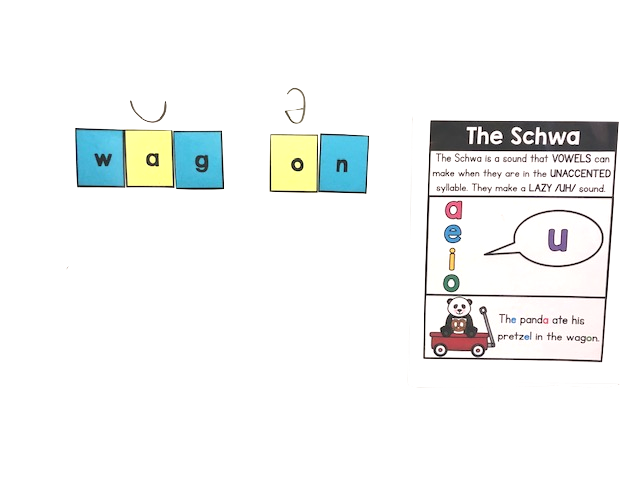
I give more opportunities to practice syllable division and labeling the vowels with the schwa. You can also just have them highlight the schwa.
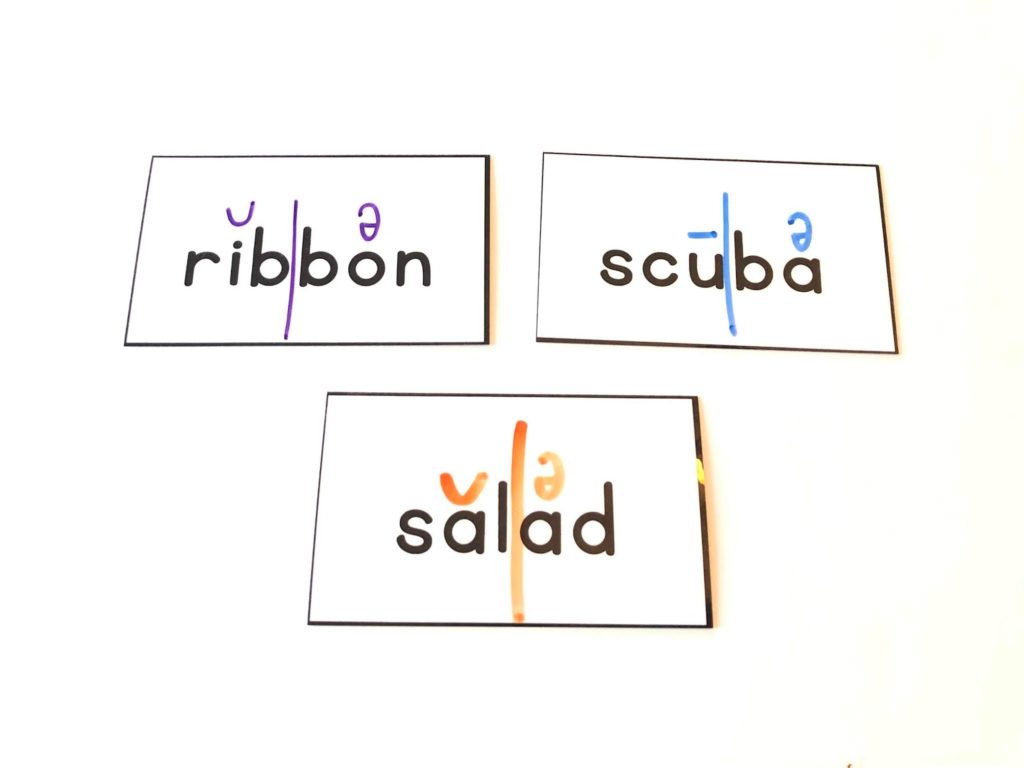
This activity is really helpful to do with a small group. They write one word at a time on white boards. They have time to do syllable division to decode. Then together we find the schwa and highlight it using these strips (transparent colored overlay sheets cut up). You can skip the white board part and just decode together too if you want.
I do sorting activities with picture cards when I’m teaching the common places we see a schwa. Then I repeat with word cards.
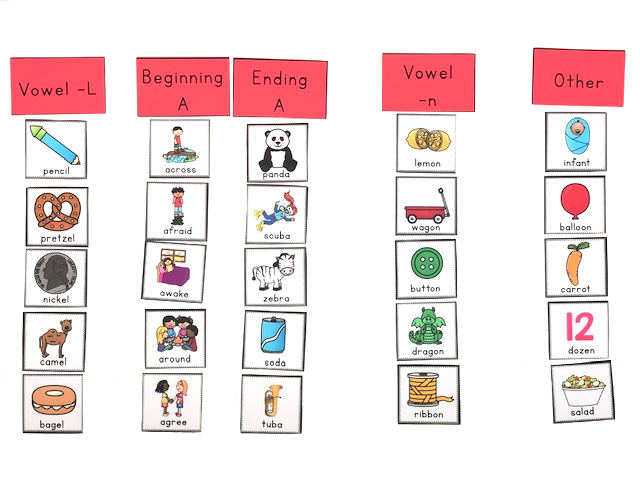
As I learn more about the schwa I will add to this post. I need more study time! I do have a few books on the way, so now all I need is time to read them! 😉
If you are looking for some teaching resources on the schwa, click here.
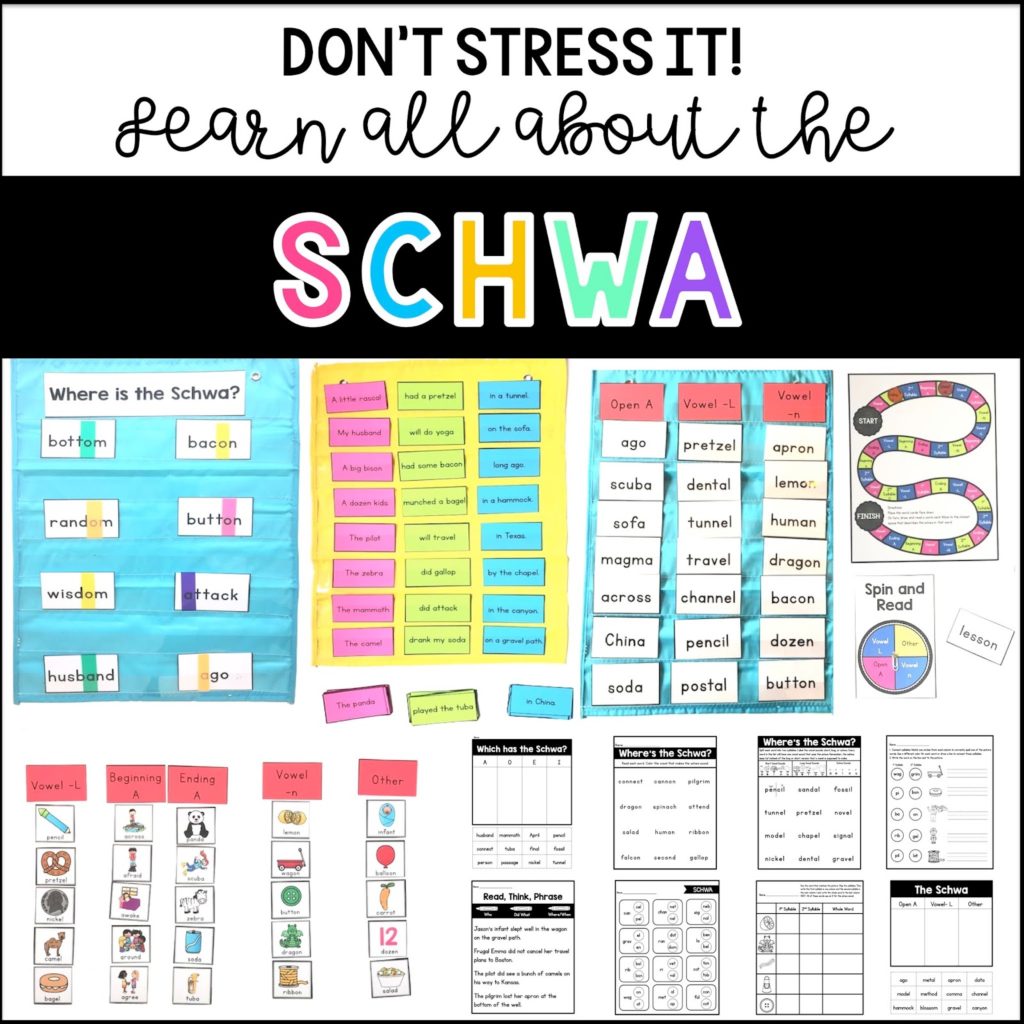
I made a poster for the schwa that I’m sharing here today for free! Click here for this free schwa poster. You can download this poster by clicking on the PREVIEW.
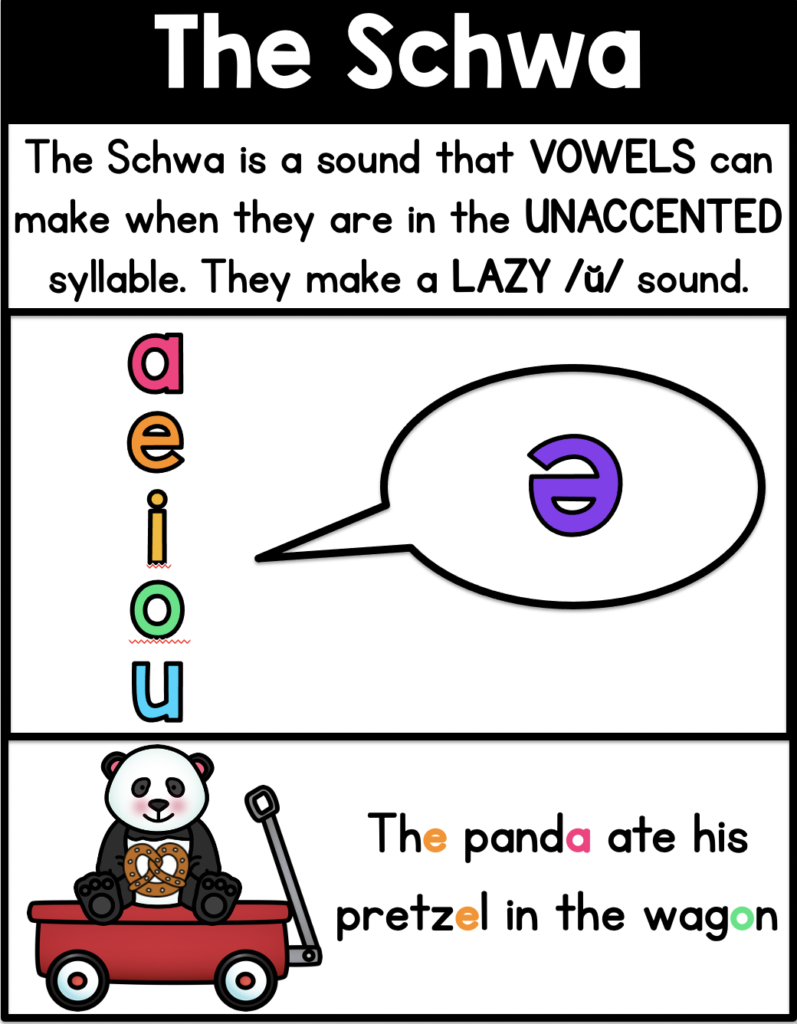
If you have more knowledge about the schwa to share, please do so in the comments. I know there is probably loads that I haven’t learned yet!
